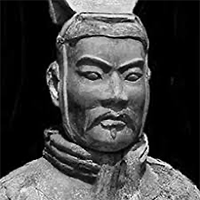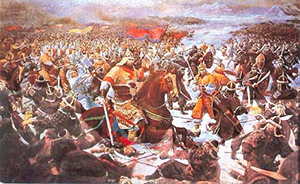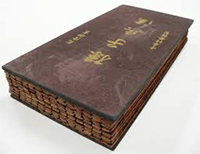Sun Tzu and The Art of War
Sun Tzu is commonly listed as the author of The Art of War, one of the most influential battle texts in history. Yet historians cannot decide on many details of his life, including whether he lived at all. (For convenience, this article will refer to Sun Tzu as a historically known person who was the definitive author of The Art of War.) 
According to the Spring and Autumn Annals, compiled by Confucius, Sun Tzu was born in Qi. A later source, Records of the Grand Historian, lists his birthplace as Wu. He is known to have served Helü, onetime king of Wu; other sources refer to him as Sunzi, Sun Wu, and Changqing. The name Sun Tzu means "Master Sun." Helü is known to have been king from 514 B.C. to 496 B.C., during the Eastern Chou dynasty. Sun Tzu is thought to have served that king from the early days of his reign in Wu and, through participation in and observation of warfare, gained inspiration for the book that bears his name. The book provided strategies and inspiration for many in the nearly constant warfare that made up the overlapping Warring States period. Sun Tzu is said to have taken part in the Battle of Boju, a 506 B.C. victory for the Wu kingdom over its rival the Chu. This pivotal battle ended the war between those two kingdoms, yet Sun Tzu features very little in accounts of the battle or the war. That could have something to do with what happened at the battle. According to the popular narrative, the king's brother, Fugai, followed Sun Tzu's advice to attack despite being outnumbered and despite the king's orders not to attack. Sun Tzu, however, had scouted the enemy and knew their weaknesses, the primary one of which was that the Chu despised their commander, Nang Wa, and shrank away from following his orders. Echoing one of the most famous observations in the book ("How victory may be produced for them out of the enemy's own tactics—that is what that multitude cannot comprehend."), Sun Tzu urged an attack and Fugai complied. The strategy succeeded so well that the Wu force drove the Chu enemy from the field, sending them reeling, and pursued them all the way to the Chu capital, Ying, which the Wu army then took as well, ending the war. These tactics flew in the face of Chinese military tradition, which portrayed warfare as a civil contest governed by a set of rules that would not be out of place in the days of medieval chivalry in the West. Sun Tzu taught that the object of fighting a war was to achieve victory and that the sooner that happened, the fewer soldiers would die, on both sides. He also emphasized the need for commanders to be flexible and to adapt their strategies to what they were seeing happen on the battlefield, as opposed to adhering to the common wisdom of how battles should be fought. One of the most well-known statements in the book is "All warfare is based on deception." Sun Tzu taught that psychological warfare was equal in importance to, if not moreso than, straightforward strategies of battlefield tactics and weaponry deployment. He considered the ability to unsettle an enemy psychologically far more of an effective strategy than the use of straightforward brute force, even if that force was an overwhelming one. The book has 13 chapters, each of which considers a different aspect of warfare:
The Art of War was a runaway success and continues to be popular, providing inspiration for military commanders to this day. As well, students of business and politics have found inspiration in what Sun Tzu may or may not have written. As for simple things like birth date and place and day and place of death, history does not record those definitively for anyone named Sun Tzu. A later strategist named Sun Bin wrote a text titled Military Methods that bears a strong resemblance to The Art of War. Some sources list Sun Bin as a descendant of Sun Tzu; other sources say that they were the same person and that he was the sole author or at least one of a few authors of the famous military treatise.
|
|
Social Studies for Kids
copyright 2002–2025
David White



 The opening chapter urges a commander to consider many things before committing to battle. Among those things to consider are the weather, the terrain, the military leaders (on both sides), and the Tao, or the Way. At the same time, a successful commander will ensure that his enemy does enjoy such luxuries: "Attack him where is he is unprepared, appear where you are not expected."
The opening chapter urges a commander to consider many things before committing to battle. Among those things to consider are the weather, the terrain, the military leaders (on both sides), and the Tao, or the Way. At the same time, a successful commander will ensure that his enemy does enjoy such luxuries: "Attack him where is he is unprepared, appear where you are not expected." Chapter 4 focuses on not risking losing the territory that a commander already controls by stretching beyond the capabilities of his army to defend. "The skillful fighter puts himself into a position which makes defeat impossible, and does not miss the moment for defeating the enemy."
Chapter 4 focuses on not risking losing the territory that a commander already controls by stretching beyond the capabilities of his army to defend. "The skillful fighter puts himself into a position which makes defeat impossible, and does not miss the moment for defeating the enemy."
